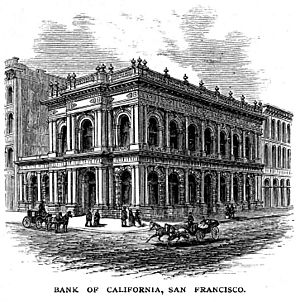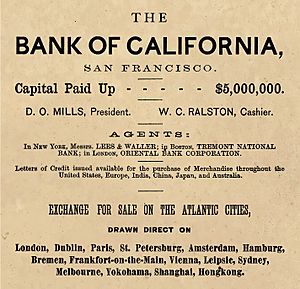Bank of California facts for kids
The Bank of California was a very important bank that opened in San Francisco, California on July 4, 1864. It was started by two key people, William Chapman Ralston and Darius Ogden Mills. This bank was the first major business bank in the Western United States. It became one of the richest banks in the country and played a huge role in helping the American Old West grow and develop.
Contents
History of the Bank of California
The idea for the Bank of California came from an earlier banking group called Garrison, Morgan, Fretz & Ralston, which started in San Francisco in 1856. William Ralston was part of this group.
In 1864, Ralston officially created the Bank of California. He sold parts of the bank (called shares) to 22 important business leaders in California. Each share cost $100.
The bank opened its doors on July 4, 1864. Darius Ogden Mills became the president, and Ralston was the cashier. A branch of the bank also opened in Gold Hill, Nevada, near Virginia City, Nevada, a few months later. William Sharon was the bank's main agent in Nevada for a long time.
The main Bank of California building in San Francisco was very impressive. It was built using stone from nearby Angel Island in San Francisco Bay. People said it was one of the most beautiful buildings on the coast.
How the Bank Helped Mining
The Bank of California played a big part in the mining boom. It lent money to many mining companies working in the Comstock Lode in Nevada. Sometimes, if a mine owner couldn't pay back their loan, the bank would take over the mine. This often led to the bank making a lot of money.
William Ralston and his business partners, known as his "Ring," became very powerful. They had a lot of control over businesses and industries in San Francisco and Virginia City.
In 1869, Ralston showed how clever he was. People were worried about the bank and started taking out their money quickly (this is called a "run on the bank"). To stop this, Ralston secretly exchanged almost $1 million worth of gold bars for gold coins from the U.S. government's treasury. When the bank opened the next morning, seeing trays full of gold coins made people trust the bank again, and the "run" stopped.
Changes in Leadership
In October 1873, Darius Ogden Mills stepped down as president. William Ralston took over as president, but he kept Mills on the board of directors because Mills's name brought respect to the bank.
The Bank's Challenges and Reopening
In 1875, there was a lot of risky trading happening with Nevada mining stocks. On August 26, 1875, another "run on the bank" happened at the Bank of California. This time, the bank struggled and had to close for a short time. William Ralston lost everything he owned.
The next morning, Ralston gave all his property to William Sharon. He then admitted to the bank's directors that there had been problems with how the bank was run, and he was removed as president. Ralston then went for a swim in the ocean, as he often did. Sadly, he did not return, and it was later found that he had died of a stroke.
The Bank of California reopened on October 2, 1875, with $2 million in gold coins ready. Darius Ogden Mills returned as president. When San Francisco created a system for banks to settle payments (a clearing house) in 1876, the Bank of California was the most important bank in the city. Other major banks included the Nevada Bank, the Anglo-California Bank, Ltd., and Wells Fargo.
In 1878, Mills retired again. William Alvord, a well-known merchant, became the new president. Under Alvord's leadership, the Bank of California became a key link for money exchanges between Europe, Japan, and China.
Alvord was president of the Bank of California until he passed away in 1904. In 1905, Homer S. King took over as president.
Bank Mergers
Over time, the Bank of California joined with other banks.
- On April 1, 1996, the Bank of California merged with Union Bank. They formed a new bank called Union Bank of California. This made them the third-largest business bank in California.
- In 2008, Union Bank of California became fully owned by a Japanese company called Mitsubishi UFJ Financial Group. The bank was then renamed MUFG Union Bank.
See also
 In Spanish: Bank of California para niños
In Spanish: Bank of California para niños




